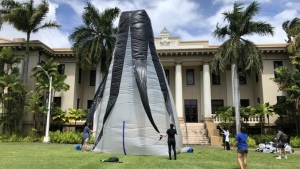Giant inflatable structures (pneumatic structures) popped up in the University of Hawaiʻi at Mānoa’s historic quad on May 3. Passers-by filled the lawn between Hawaiʻi Hall and the School of Architecture to see eight pneumatic structures designed and built by 65 first-year architecture students. The structures are constructed of plastic that is welded and taped together.
Everyday household standing fans inflated the pneumatic structures, some of which could hold about 70 people inside. The exhibit was a final project for students in Architecture 102, a beginning design studio course.
“I think teamwork is everything,” said first-year architecture student Michael Bennett, a former NFL all-star player and Super Bowl champion. “For me playing in the NFL for 12 years everything was about teamwork. When you think about design it’s all about teamwork. Everybody’s doing something, everybody’s adding to the process.”

Students studied conditions onsite, such as wind, rain and topography, and features such as trees. The construction of the inflatables gave students a chance to see how their design compared to what they imagined and anticipated.
The gusty weather added a level of difficulty to the exhibit. Students battled the winds and several projects suffered damage during the presentation. Bennett joked that working on this project was more difficult than playing in the Super Bowl.
“It is the first, and one of the few chances in architecture school, for students to design and build a full-scale structure,” said Lance Walters, associate professor in the School of Architecture. “Rather than only models and drawings, the students are able to realize full-size spatial environments.”
This project gives architecture students a rare opportunity to actually build a full-size, inhabitable structure. It is the first time since 2019 that the inflatable structures have popped up on the lawn due to the COVID-19 pandemic.
This event is an example of UH Mānoa’s goal of Enhancing Student Success (PDF), one of four goals identified in the 2015–25 Strategic Plan (PDF), updated in December 2020.

